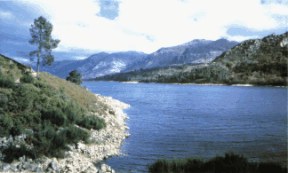|
|
|
|

| This
was the first protected area to be founded in Portugal in 1971 and it is
the only National Park in the country. Having once been the home
of the brown bear and the mountain goat, Peneda-Geres is today one of the
last refuges of the great predators, such as the wolf and the royal eagle.
Text
provided by the Portuguese Tourist Office
Because of this, flora and fauna are found that are rare or non existent in other parts of the country. Human occupation dates back 7,000 years and Megalithic, Celtic and Roman monuments are found frequently. Memory and inheritance from these times are the vestiges of community life, almost extinct today but still present in certain isolated points where they have still survived the modern manifestations of human intervention. The vast heritage still to be found makes Peneda-Geres an essential visiting point for anyone who wishes to discover the Parks of Portugal. Two
mountain plains - Castro Laboreiro (to the North) and Mourela (to the East)
- form the boundaries of the granite semi--circle that makes up this Park.
Between the two are the mountains of Peneda (1373 m), Soajo (1217 m), Amarela
(1092 m) and Geres (1545 m), the highest and most extensive.
The mountain populations have always lived mainly from shepherding. Their community life still remains in the their herding, where each shepherd takes turn at taking the village herds to graze on the mountain slopes. In Peneda and Soajo there are traditionally two homes: the winter quarters "inverneiras" - in the main village at a low altitude and used during the colder months - and the "brandas" - used in the Spring and from where the populations go in search of mountain pastures. The typical vegetation of the region is oak. It is almost always the black oak that predominates, coexisting with an impressive diversity of ferns, mosses, lichen, mushrooms and other plants such as the endangered holly. There
are woods where the Geres lily can be found, but the plants are mostly
heather, genista, gorse, broom, gramineous plants and juniper. This latter,
like the woodland pine, the yew, the white birch and the rare Geres fern,
is a true relic of glacial flora.
Although some of the species are now extinct, such as the brown bear and the mountain goat, the National Park still presents a very varied fauna, with important species like the wolf, the roe deer, the wild boar, the fox, the wild ferret and the otter. Of special importance among the bird species are the endangered royal eagle, the kite, the woodland screech owl and the titmouse. Among the reptiles the most important are the rarely found Seoane viper and the horned viper, as well as the water snake, the water lizard and the green lizard. Amphibians of special note are the rare Lusitanian salamander, the tritons, the Iberian frog and the midwife toad. |
| Area | 72,000 hectares | |||||
| Park Office | Quinta das Parretas, 4700 Braga | |||||
| Situation | North east corner of Portugal | |||||
|
|
Return to Parks index